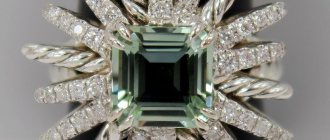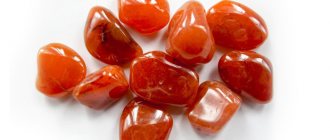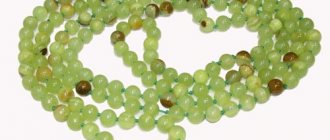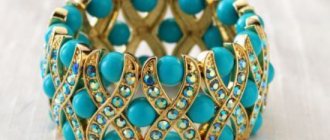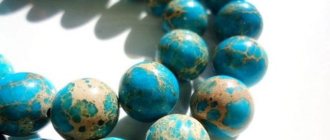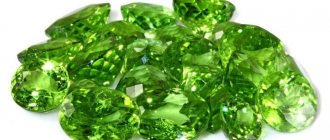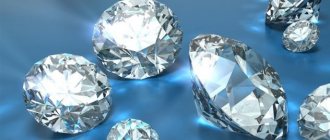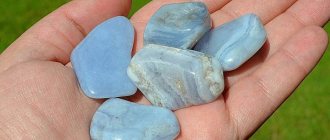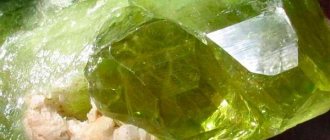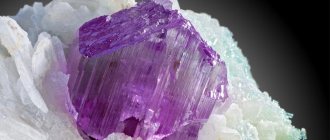Hypersthene is a rock-forming stone and represents a group of silicates. This is a fairly rare mineral. Its color palette depends on admixtures of elements such as iron and magnesium, and includes yellow, green, brown and black shades. Usually it is a translucent, translucent or opaque stone, which is characterized by glass and mother-of-pearl luster. Transparent specimens of hypersthene, which are particularly valuable, are not often found.
In terms of its chemical composition, hypersthene is a magnesium silicate, which has a dense granular structure. This mineral is very fragile. It has a tabular or thick columnar structure.
Hypersthene has been known for many centuries. Translated from Greek, its name means “extra strong.” The name of the mineral hypersthene was recorded by the mineralogist Gaüy in 1803. However, over time, its official name began to disappear from use. Mineralogist Kenngott in 1855 assigned a new name to this stone: “enstatite”. Its translation sounds like “opposing”. This name still appears in descriptions of the mineral.
Physico-chemical characteristics
For a chemist, hypersthene is a complex magnesium silicate of igneous origin.
| Color | Black-brown, black |
| origin of name | From Greek very strong |
| IMA status | not valid |
| Chemical formula | (Fe, Mn)2[Si2O6] |
| Shine | glass metal-shaped |
| Transparency | opaque |
| Hardness | 5 — 5,5 — 6 |
| Thermal properties | Melts into greenish-black glass. |
| Specific gravity | 3,4—3,5 |
| Selection form | thick columnar crystals, tabular crystals |
| Classes on taxonomy of the USSR | Silicates |
| IMA classes | Silicates |
| singonia | rhombic |
The color of this rare rock-forming mineral is determined by the ratio of iron, magnesium, chromium, and aluminum in the composition.
Description of the stone
The stone contains iron and magnesium - its appearance depends on the proportional ratio of these microelements. The color of hypersthene varies between green and brown. Typically, these are semi-translucent or opaque crystals, with a shiny surface that attracts the eye with a pearlescent or glassy sheen.
Transparent samples are extremely rare - accordingly, they are the most expensive. The structure of the stone is dense, granular, high hardness - 6 points on the generally accepted Mohs scale.
Varieties
The composition of hypersthene from different deposits does not always correspond to the base one. Depending on this, there are several types of stone:
- A variety of hypersthene with an admixture of chromium, which gives a yellow-green tint, is called bronzite. Its formula differs from the main “hypersthene” formula.
- In addition to chromium, bronzite of lunar origin contains a high percentage of titanium.
If you remove the greenish inclusions, it will be impossible to visually distinguish bronzite from gold.
How to care for hypersthene
The mineral lives up to its name - super durable. Products made from such material are not afraid of temperature changes, contact with sharp edges of other jewelry, and even aggressive chemicals do not immediately affect the stone. Therefore, you don’t have to worry about where to store and how to wear hypersthene - a common box will suit it, and if you want to recover from some disease, you can leave it on for several days.
Of course, over time, the stone will become dusty and dirty - in this case, just wash it thoroughly with liquid soap and water and let it dry, placing it on a dry cloth.
Ferrous enstatite is a stone that has practically no disadvantages. It pleases the eye, cures illnesses, wards off misfortune and never shows negative energy. If you have the opportunity to purchase such beauty, don’t hesitate!
Place of Birth
Sources of replenishment of hypersthene reserves are the earth's interior, the Moon and meteorites.
Among European countries, Ukraine, Germany, Finland, and Norway produce the most minerals. In Asia these are Iran, India, Sri Lanka. On the American continent - Canada.
Russian stone deposits are located in the vicinity of Lake Baikal.
Much more often (on the Moon and all continents, including Antarctica) bronzite is found.
Form of being in nature
The appearance of crystals . The crystals are rare, prismatic, sometimes tabular along (100) or (010).
twins according to (100) are considered as slip twins. In GG. gas-liquid inclusions located parallel to the vertical axis are observed; inclusions of glass and magnetite are known in samples from volcanic rocks. Hypersthene from dacites of Transcarpathia contains inclusions of magnetite and ilmenite; in hypersthene from garnet-hypersthene charnockites of Transnistria - inclusions of pyrrhotite, pyrite and chalcopyrite; in the hypersthene from the Budulan meteorite there are inclusions of metallic iron. In addition, inclusions of plagioclase, olivine, biotite, apatite, and zircon are common.
Aggregates. Crystals, grains, dense leafy masses, spherical aggregates.
Where is it used?
The mineral hypersthene has found application in accordance with aesthetic standards:
- Industrialists use brownish granular mass as a raw material.
- Powdered hypersthene becomes an additive in powder, blush, and foundation.
- Jewelers get golden and green-brownish scaly bronzites. The stone is most valued for these scales: they are like gold and fresh autumn leaves.
- Master stone cutters carve balls, pyramids, animal figurines, and other small plastic materials.
- Collection collectors are hunting for colorless, lunar and meteorite specimens.
Hypersthene ring
Decorators value hypersthene stone for its resemblance to gold. Jewelry with it looks expensive, stylish, and at the same time affordable.
Industries of application of hypersthene
Samples of hypersthene are valued by jewelers and craftsmen. When creating jewelry, specimens of brownish-green and nut tones are most often used.
Cabochons (smooth ovals of stone) look beautiful in pendants, rings, earrings and bracelets. They are usually small in size, because getting a gem-quality mineral is a great success. The crystal is suitable for small sculptures, vases, decorating household items and various souvenirs.
This mineral produces impressive three-dimensional balls, which can serve as decoration in a festively decorated room or be used as equipment for Eastern practices, for example, during yoga classes.
This stone can be seen in museums and private collections. The largest green hypersthene weighs 12.97 carats and is located in the Royal Canadian Museum. The transparent exhibit, weighing 11 carats, is kept at the Smithsonian Institution.
Hypersthene crystals are purchased by companies producing cosmetics.
The mineral, crushed to a powdery mass, is added to blush and powder to give the skin a seductive natural shade and further remove redness and inflammation.
Price
Jewelers classify hypersthene as ornamental; anyone can buy products with it (price / rub.):
- tumbling (1.5-2.5 cm; Canada) – 260 – 380;
- pendant – 980 – 1 180;
- ring (silver) – 1,650 – 4,390;
- earrings (silver) – 3,800 – 5,300.
Tumbling Hypersthene
The price depends on the size and location of the stone.
Care instructions
Necklace with hypersthene stone
Despite the average hardness, hypersthene is a fragile stone. When storing it, you should adhere to certain care rules:
- protect from impacts and falls; when in contact with harder stones, hypersthene can be easily scratched;
- do not allow cleaning agents containing abrasives or acids to come into contact with the surface of the mineral;
- do not leave products with stone near heating elements, protect from overheating;
- wash the stone with cool water and soap and a soft cloth;
- After washing, wipe the surface of the gem dry so that there are no traces of water deposits left on it and rust does not appear.
Hypersthene is not afraid of exposure to open sun. Under its rays, it receives an energy charge, which it subsequently transfers to its owner.
Magic properties
The mineral is endowed with a dual nature: it helps in witchcraft of any “color”.
At the everyday level, the magical properties of hypersthene are also useful:
- The stone creates a barrier to any external negativity, including curses and love spells.
- The fiery nature plus the power of the Sun make the stone a talisman for people in risky professions (firefighters, rescuers, police officers, car enthusiasts).
- His magic is shown to insecure, shy people.
The type and dimensions of the talisman do not matter: the decoration or stone can be anything.
Astrological compatibility
Since this mineral concentrates the power of light, it is ideal for fire signs:
- Sagittarius;
- Leos;
- Virgos.
The crystal will protect them from spontaneous actions leading to sad consequences, unjustified risks, and unwanted coincidences. They will remain bright personalities, but at the same time they will learn to remember the “golden mean” and not succumb to the hurricane of momentary feelings.
Despite the eternal conflict between Fire and Water, hypersthene also favors Aquarius. Opposites attract, so representatives of the constellation can count on the stone to make them more emotional, capable of more vividly feeling joy and happiness.
As for other zodiac signs, they should not be afraid of the magic of the gem. Hypersthene is an amazing stone; its magical properties never conflict with human energy. The gem will make their inner world more orderly - perhaps some of its properties will weaken due to certain characteristics of the sign, but none of the qualities of the stone will cause harm.
Therapeutic effect
The origin of hypersthene determined its wide healing potential:
- Control of the owner's immunity.
- The fight against acute respiratory infections, acute respiratory viral infections and their prevention.
- Normalization of prostate function in men.
- Preventing hormonal imbalances.
Brown stones are also useful for weight loss.
The use of dense green specimens is suitable for normalizing the psyche and emotions. They relieve migraine attacks and the consequences of weather dependence. They restore visual acuity
The positive effects of the stone will be equally felt by hyper- and hypotensive patients.
The power of the mineral
This mineral is credited with healing and, to a lesser extent, magical powers. Due to its resinous black hue, unknowing people often mistake the mineral for other stones. For example, the Nuumite stone has the same black color, but the properties of the stones differ in many ways from hypersthene.
It is believed that it will be an excellent assistant in the fight against many diseases. Its healing substances will help get rid of absent-mindedness, and green crystals have a positive effect on vision. Helps normalize the immune system and hormonal levels of the human thyroid gland. Fights viruses, speeds up metabolism. It has a positive effect on almost all vital systems of the body.
Magical properties are most expressed in protective amulets, talismans, various amulets, and can protect against various injuries, accidents and wounds. Unlike the numite stone, it does not have much magical power. The latter is widely used in magic for various rituals.
The properties of nuumite give magicians ancient energy. The use of hypersthene in the magical sphere is still only being studied.
Combinations with other stones and differences from fakes
Processed stones are set in a frame made of gold, silver, platinum and other alloys. They combine enstatite with emerald, ruby, spinel, chalcedony, agate, lapis lazuli, jade, and opal. The mineral is rarely counterfeited; the opposite often happens; good specimens can be passed off as emerald.
Enstatites are artificially synthesized by exposure to temperatures above 900°C and 1 atm pressure or using hydrothermal synthesis. Experiments are also being carried out on combining with other pyroxenes in the Mg-Si oxide system.
Story
The first stones were found in the Czech Republic and were taken as the national gem of this country: transparent enstatite looks like a green garnet.
Later studies showed that it is magnesium silicate from the pyroxene group.
There's a whole story behind the name:
- It was first invented by René Haüy in 1803. He took into account the properties of enstatite: resistance to melting, acids, and other aggressive substances and called it... hypersthene. That is, “super strong”.
- Half a century later, in 1855, at the suggestion of the German scientist Gustav Kenngott, the stone began to be called enstatite. The ancient Greek "enstatos" means "opposing, opposing."
Jewelers and gemologists also use the term “enstatite-hypersthene”.
But the name “enstatite” is considered archaic.
